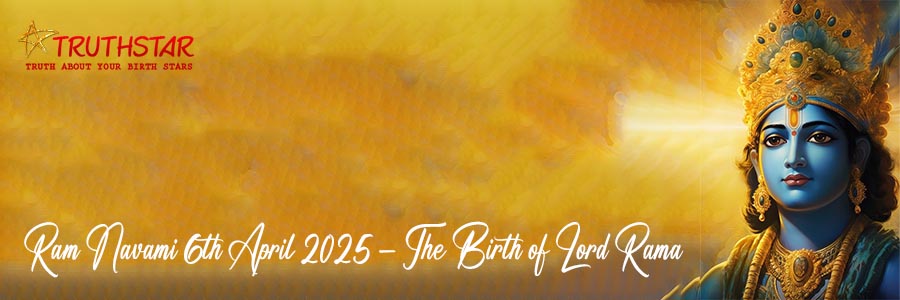Ram Navami

Ram Navami in 2025 is on Sunday, the 06th of April
Birth day of Sri Rama, seventh incarnation of Vishnu
Sri-Ramnavami is dedicated to the memory of Lord Rama. It occurs on the ninth day (navami). The festival commemorates the birth of Rama who is remembered for his preperous and righteous reign. Ramrajya (the reign of Rama) has become synonymous with a period of peace and prosperity.
This Year Ram Navami will be celebrated on 06th April 2025
The birthday of Lord Rama, the celebrated hero of the famous epic, ‘Ramayana’, is enthusiastically celebrated all over India. Lord Vishnu is worshipped in his human incarnation as Rama, the divine ruler of Ayodhya.
Lord Rama is a legendary figure, the epitome of all that is good and true, the man who vanquished the demon king Ravana. Lord Rama is not just a hero, but has been given the status of a god by the Hindus. Therefore, it comes as no surprise that his birth is celebrated year after year with great pomp & show .
Temples of Rama are decorated, religious discourses are held and the Ramayana is recited for ten days. People sing devotional songs in praise of Rama and rock, images of him in a cradle to celebrate his birth. Rathyatras or chariot processions of Rama, his wife Seeta, brother Lakshmana and devotee Hanuman are held from many temples. The chariot is accompanied by several devotees dressed up in ancient costumes as Rama’s soldiers. The procession is a gusty affair with the participants shouting praises echoing the happy days of Rama’s reign.
Everyone participates in the puja by first sprinkling the water, roli, and aipun on the gods and then showering handfuls of rice on the deities. Then everybody stands up to perform the arti at the end of which ganga jal or plain water is sprinkled over the gathering. The singing of bhajans goes on for the entire puja.
Finally, the prasad is distributed among all the people who have gathered for worship.
Fasting
Some observe a strict fast on this day. The diet of such a person would include potatoes made in any form without haldi (turmeric), garlic, ginger or onion. He can also eat fruit and root vegetables of any kind. Curd, tea, coffee, milk, and water are also permitted
On the face of it Sri-Ramnavmi appears to be just a festival commemorating the reign of a king who was later deified. But even behind present-day traditions there are clues which unmistakably point to the origin of Ramnavmi as lying beyond the Ramayana story.
A huge fair is held in Ayodhya (Ram Janam Bhumi) on Ram Navami day, where thousands of devotees gather to celebrate this festival.
In Andhra Pradesh:
Ram Navami is a major festival celebrated with great religious fervour and devotion. It is celebrated for 10 days from the Chaitra saptami to the Bahula Padyami that fall in the month of March and April. Rambhaktas visit temples where Rama’s birthday is celebrated by the re-enactment of his marriage to Sita. For this reason Ram Navami is also called the Kalyanotsavam.
In Other Parts Of South India
Besides the usual fasting and prayers, a most delightful tradition that is practised as a part of the Ram Navami celebrations in south India is the narration of stories. Talented storytellers are known to narrate episodes of the Ramayana adding local flavour and humour to it. This is essentially a folk tradition and still continues in villages and small towns.
The Sun is considered to be the progenitor of Rama’s dynasty which is called the Sun dynasty (Raghukula or Raghuvamsa, Raghu means Sun and Kula or Vamsa mean familial descendant). Rama is also known as Raghunatha, Raghupati, Raghavendra etc. That all these names begin with the prefix Raghu is also suggestive of some link with Sun-worship. The hour chosen for the observance of the lord’s birth is that when the sun is overhead and is at its maximum brilliance. In some Hindu sects, prayers on Ramnavami day start not with an invocation to Rama but to Surya (sun). Again the syllable Ra is used in the word to describe the sun and brilliance in many languages. In Sanskrit, Ravi and Ravindra mean Sun.
Latest Articles
- Understanding the Power of Compound Numbers in Numerology
- May Day Spring Festival of Fertility
- Remedies to cast away the evil effects of nine planets
- Yogakaraka Planets
- How To Know About The Lost and Stolen Item
- Astrological Easter Traditions from Different Cultures
- Easter eggs based on Zodiac Signs
- Exalted and Debilitated Planets in a Birth Chart
© 2025 by Truthstar Future Vision Pvt Ltd All Right Reserved



